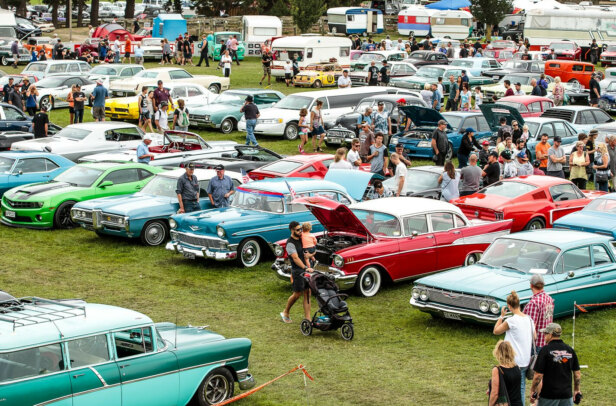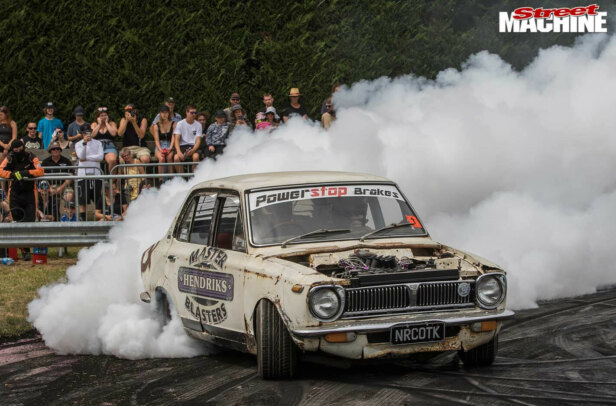AFTER I lost my last Pontiac Bonneville in a shed fire last year (SM, Dec 14), I was determined to get back on the horse and source a replacement.
Problem is, I am a picky sod and didn’t want a Canadian-assembled right-hook example that was sold in Oz back in the day. It had to be a ridgy-didge, wide-track Poncho-powered hardtop coupe or sedan. And that meant it had to be imported, as is the case for most classic US tin that isn’t a Mustang, Impala or Camaro.
FINDING YOUR RIDE
America is a big country, just like Australia, and so it can cost a bomb to ship a large car to the port of departure, especially if it is coming from the Deep South or Mid-West. For this reason, along with the fact the western states are considered ‘dry’, I decided to look for my next car in California, Nevada, Arizona and Texas. That said, you can still find plenty of rusty old cars in those states!
I ended up stumbling onto a 1964 Bonneville coupe in Huntington Beach, California, thanks to a mate tagging me in a Facebook post. After exchanging some emails to find out the general condition of the car, I was hooked.
The Bonneville belonged to none other than Coby Gewertz, the man behind the amazing Church magazine. The car certainly had style, but I wasn’t so star-struck that I was going to buy it sight-unseen.
INSPECTION
Through a mate, I found a local who agreed to check the car out in person. If you don’t have anyone near a car you want to buy, there are quite a few businesses that can inspect classic cars and issue a pre-purchase report for a fee.
The inspector takes a bunch of photos of the car, noting rust, modifications and how it drives. The seller and I agreed on a price and I transferred the funds to him via foreign exchange company OzForex, who had significantly better rates than any bank I could find.
THE PAPERWORK
No car or trailer can be imported into Australia without a valid Vehicle Import Approval, a piece of paper from the Federal Department of Infrastructure. You also need the clear title on the car, though that comes in later on.
The VIA application form is available online, and for pre-1989 imports it is logical and straightforward. You need scanned copies of photo ID, including licence and passport, a bill of receipt for the purchase of the vehicle, a couple of photos of the car and registration documents for the car. There is a non-refundable $50 fee, which can also be paid online, and processing times are up to 20 business days.
Be extremely careful buying any vehicle that has major modifications, as they will most likely be denied entry to Australia. Late-model engine swaps, chassis and tub work and major body mods are all going to be difficult, if not impossible, to get through.
ON THE DOCKS
Once you have your VIA, it’s time to get the car to a freight agent, in my case Auto Shipping (www.autoshipping.com.au).
Dominic Bonasia from Auto Shipping arranged to have my car booked onto a boat through a handling company called HTX International.
I had the previous owner drop the Bonneville at their depot in Carson, Los Angeles. HTX International were responsible for packing the Pontiac Bonneville into a shared container and organising to get it onto the boat headed for Botany, Sydney.
Being such a huge old barge, the boys had to struggle into the container to get the Bonneville out
Christopher Lemire from HTX International explains the process: “The person dropping the vehicle off is given a receiving report with the vehicle information and then one of the receiving guys meets them outside at the vehicle to have the car written up.
“That person then gets a copy of the report and they are free to go. The receiver takes pictures of the vehicle condition, including all faults. After that the car is taken into the warehouse waiting to be loaded and sent out.”
ON THE WATER
Depending on the port facilities, there are three main ways to ship cars internationally: roll on/roll off, shared container or sole-use container.
Dominic explains: “The main West Coast ports are Tacoma, Oakland and Los Angeles, and most vehicle freight coming out of them is via consolidated [or shared] containers.
“The main ports on the East Coast are Charleston, Baltimore, New Jersey and Savannah, Georgia. These offer roll on/roll off (RORO) or shared container, but the freight takes three times as long as the West Coast and the prices are about 30 per cent more.
“Direct sailing from Los Angeles is around 20 days to the first eastern Australian ports, while transhipment sailings are around 30-35 days. Transhipment is where the container is unloaded and then reloaded on to a different ship at a port during the voyage.
Once it saw the Aussie sun for the first time, the Poncho went for quarantine cleaning and Customs clearance
“Shipping out of San Francisco area generally costs around 20 per cent more than going out of Los Angeles, but every shipper has different rates out of the USA. You should check them carefully as some do not list separate handling fees, and hide it in their freight and unpack charges.”
My car ended up being caught in the tail end of a waterfront wage dispute, adding around three weeks to the shipping time. This dispute has now been resolved, so shipping times should be back to normal by the time you read this.
ALMOST HOME
If you’re importing the car yourself, there are several pieces of paperwork that come in when the ship is around a week out from port, and they’re important because they’re required for Customs clearance and valuation. The Bill of Landing, Arrival Notice and Notice Of Disbursement will be required by any Customs clearance agency you use; unless you’re an import expert you should hand this work off.
To get through Customs you will need your VIA, a scan of your passport and the scanned receipt for the vehicle. While a pre-’89 classic escapes paying duty, you will be hit with GST, calculated as 10 per cent of the combined value of the car, cost of freight and cost of shipping insurance together.
THE BILL
Due to Auto Shipping and SEAGO (the company who actually freighted my car across the water) having organised pre-paid express release, I was handed one bill for the freight and destination charges (see sidebar), but not all freight companies work like this and some will need you to pay the shipping invoice to avoid storage fees on the docks, or unpack yard.
SEAGO arranged to have the container unpacked at the Price & Speed yard in Pagewood. The car was then moved to a quarantine inspection yard where it was cleaned and inspected. As with almost every car that comes into the country, it failed inspection and was cleaned again.
Once it passed that final hurdle I paid my bill to Auto Shipping and was free to organise a tow truck to pick the Poncho up. Don’t lag at this step, however, as storage charges can be due at many yards if you don’t pick the vehicle up within one or two days.
Want someone to handle the whole lot? There are heaps of companies who will do it for you, such as USAtoAUS.com.
PAY UP, SUCKER
This is the breakdown of what it cost to take my car from being dropped off at the docks in Los Angeles, to being ready to pick up in Botany, Sydney.
While I saved money not having to transport the car from elsewhere in the USA, the Bonneville was deemed ‘oversize’ for shipping due to its length and width, as many full-size classic American cars (and most pick-ups) are.
Standard-sized cars like Mustangs and Camaros are cheaper in two areas. A rough guide price for them would be $1800 (USD) for ocean freight and packing, and around $1500 for Australian destination unpack and clearance.
- Ocean freight and packing from Long Beach: $2295 (USD)
- USA export clearance charges: $195 (USD
- Marine insurance 1.5% or minimum: $330 (AUD, optional)
- Australian destination unpack and Customs clearance: $1695 (AUD)
- Handling management fee: $195 (AUD)
- Quarantine inspection and attendance fees: $280 (AUD)
- Cleaning and re-inspection by quarantine: $300-$400 (AUD)
- IMPORT DUTY: 5 per cent (free if over 30 years old)
- IMPORT GST: 10 per cent (based on insured value + duty + freight + shipping insurance)
TOTAL: $7194.50 (AUD)
TAPPY’S CHEV
SM photographer Chris Thorogood has also imported a big Yank tank, namely a ’59 Chev Brookwood wagon. “My previous car was a ’61 Buick,” Chris says. “It was a cool thing, but I made the mistake of not looking at it hard enough, and there was a lot of rust and poor modifications to deal with. So this time, I made sure I put a lot more effort into getting it inspected. The seller sent me a lot of photos, so I could get a good idea of the condition, then I used an inspection service to check it out for me.
“Once I had negotiated a deal, I used the inspection service to organise the storage (while I waited for the VIA to come through) and transport to the shipping yard. They also organised to fit some new wheels and tyres for me. It went fairly smoothly, although the VIA took a long time to come through and I got hit by some big fees by Australian Customs that I wasn’t expecting. The big thing is to be very wary of cars that have been modified, especially airbagged cars. They are unlikely to pass muster in Australia!”
- Inspection, storage and transport: $1400
- Shipping: $2200
- Stinkbug fumigation $250
- GST, custom inspections, unloading, cleaning: $4400
TOTAL: $8250.00 (AUD)




Comments